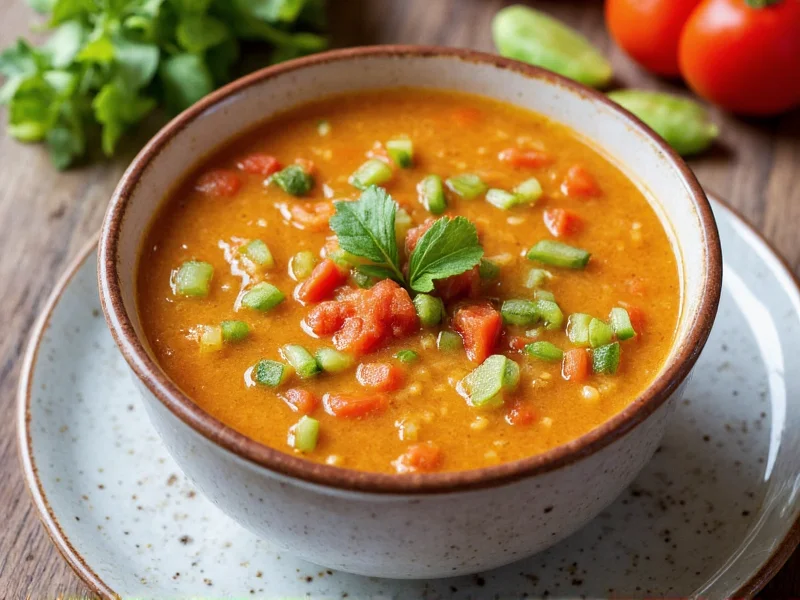Freezing vegetable soup is one of the most practical ways to preserve homemade meals while maintaining nutritional value and flavor. Whether you've prepared a large batch for meal prep or want to save leftovers, understanding the science and techniques behind proper freezing ensures your soup retains quality from freezer to bowl. This comprehensive guide covers evidence-based methods that professional chefs and food safety experts recommend for freezing vegetable-based soups.
The Science Behind Freezing Vegetable Soup
Vegetable soup presents unique freezing challenges compared to meat-based soups due to its high water content and delicate vegetable components. When water freezes, it expands, which can cause cell walls in vegetables to rupture, potentially altering texture upon thawing. The key to maintaining quality lies in controlling ice crystal formation through rapid freezing and proper packaging.
Starchy vegetables like potatoes and carrots generally freeze better than watery vegetables like zucchini or tomatoes. Adding acidic ingredients (like tomatoes or lemon juice) after thawing rather than before freezing helps maintain flavor integrity. Understanding these principles allows you to adjust your technique based on your specific vegetable soup recipe.
Step-by-Step Freezing Process
Follow these professional-tested steps for optimal results when freezing vegetable soup:
- Cool completely - Allow soup to cool to room temperature within 2 hours of cooking. Never put hot soup directly in the freezer as it raises the freezer temperature, potentially compromising other frozen items.
- Portion strategically - Divide into single-serving portions (typically 1-2 cups) for convenient thawing. Consider your typical consumption patterns when determining portion sizes.
- Select appropriate containers - Choose freezer-safe options with minimal headspace. Glass jars require 1-1.5 inches of headspace for expansion, while rigid plastic containers need 0.5-1 inch.
- Remove excess air - For freezer bags, press out as much air as possible before sealing. Consider the water displacement method for optimal air removal.
- Label thoroughly - Include soup type, date, and any special ingredients that might affect reheating.
| Container Type | Best For | Storage Duration | Special Considerations |
|---|---|---|---|
| Rigid plastic containers | All vegetable soups | 6 months | Leave 0.5-1 inch headspace; stackable |
| Freezer bags | Broth-heavy soups | 4-5 months | Lay flat to freeze for space efficiency |
| Glass jars (wide-mouth) | Chunky vegetable soups | 4 months | Leave 1-1.5 inches headspace; avoid narrow necks |
| Silicone molds + bags | Broth for cooking | 6 months | Freeze cubes first, then transfer to bags |
Maximizing Shelf Life and Quality
While frozen vegetable soup remains safe indefinitely when stored at 0°F, quality degrades over time. For best flavor and texture:
- Consume within 4-6 months for optimal quality
- Store at consistent 0°F or below (fluctuating temperatures accelerate quality loss)
- Place containers toward the back of the freezer where temperature is most stable
- Avoid opening freezer frequently during storage
Signs your frozen vegetable soup has deteriorated include excessive ice crystals throughout the container (indicating temperature fluctuations), darkened vegetables, or off odors upon thawing. Small amounts of surface ice are normal, but large ice chunks throughout suggest repeated thawing and refreezing.
Thawing and Reheating Techniques
Safe thawing preserves both food safety and quality. Never thaw frozen soup at room temperature for more than 2 hours. Recommended methods include:
- Refrigerator thawing (best quality): Transfer container to refrigerator 24-48 hours before needed
- Cold water bath (faster method): Submerge sealed container in cold water, changing water every 30 minutes
- Direct reheating (most convenient): Add frozen soup directly to pot with small amount of liquid
When reheating, bring soup to 165°F (74°C) throughout. Stir occasionally for even heating. For best flavor restoration:
- Add fresh herbs after reheating
- Stir in a small amount of cream or olive oil for richer texture
- Adjust seasoning as flavors may have mellowed during freezing
- Add quick-cooking vegetables (like spinach) during final reheating
Troubleshooting Common Freezing Issues
Even with proper technique, you might encounter these common challenges with frozen vegetable soup:
- Separation: Some separation is normal. Simply stir well during reheating. For emulsified soups, consider blending after thawing.
- Texture changes: Root vegetables generally maintain texture better than watery vegetables. Consider adding delicate vegetables fresh when reheating.
- Flavor loss: Acidic components (tomatoes, lemon) can become muted. Brighten flavors with fresh acid after reheating.
- Freezer burn: Caused by air exposure. Trim affected portions before reheating; prevent by removing excess air from containers.
Homemade vs. Store-Bought Frozen Vegetable Soup
While store-bought frozen vegetable soup offers convenience, homemade versions typically provide superior quality and customization. Commercial soups often contain stabilizers, excess sodium, and preservatives to maintain quality through industrial freezing processes.
When evaluating store-bought options, check for:
- Short ingredient lists with recognizable components
- Sodium content under 480mg per serving
- Absence of artificial preservatives and flavor enhancers
- Vegetable content that appears substantial in packaging images
For those considering batch cooking, freezing your own vegetable soup allows complete control over ingredients, sodium levels, and vegetable variety while typically costing less per serving than premium store options.
Seasonal Considerations for Freezing Vegetable Soup
The vegetable composition of your soup affects optimal freezing duration. Summer vegetable soups (with tomatoes, zucchini, corn) generally have shorter freezer lives (4 months) compared to winter vegetable soups (with root vegetables, squash, beans) which can maintain quality for 6 months. This difference stems from the varying water content and cellular structure of different vegetables.
When preparing vegetable soup specifically for freezing, consider building flavor foundations that withstand freezing well. Mirepoix (onion, celery, carrots), garlic, and herbs like thyme and rosemary maintain their character through freezing better than more delicate ingredients.











 浙公网安备
33010002000092号
浙公网安备
33010002000092号 浙B2-20120091-4
浙B2-20120091-4